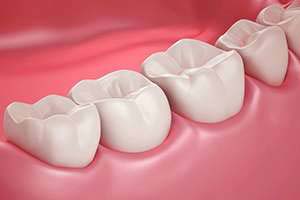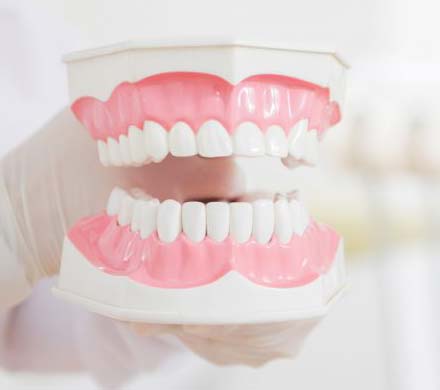

İnternet sitemizde çerezler kullanılmaktadır. Çerezleri nasıl kullandığımız hakkında daha fazla bilgi için Çerez Politikamız'ı ziyaret edebilirsiniz. Aşağıda yer alan “Tamam” butonu ile tüm çerezleri kabul edebilirsiniz.
Tamam
Even healthy teeth without decay can be lost due to gum disease. For this reason, the protection of the health of the surrounding tissues (gums, bones) is as important as the protection of general dental health.
Healthy gums are light pink in color, matte, hard in consistency, end like a knife edge on the tooth surface and do not bleed during brushing.
Gum disease (periodontal diseases) covers a wide area from a simple gum infection (gingivitis) to severe infections where the jaw bones are resorbed and teeth are lost by shaking (periodonticis).
With the diseases, the gums swell, red, bleed, recede, teeth lengthen, bad breath occurs, teeth are replaced, their gaps are opened and eventually teeth are lost.
Gingival bleeding, which is one of the most important symptoms of gum disease and can be easily noticed by the patient, occurs spontaneously while brushing teeth, eating hard foods.
These diseases are generally chronic diseases. Although the disease is present, it may not go unnoticed for a while. If the gums are bleeding and enlarged, if there are dental stones, gingival
recession, elongation, displacement or mobility in the teeth, bad taste and odor in the mouth, a gum disease specialist (periodontologist) should be visited.
Microbial dental plaque is the most important known cause of gum disease; However, some systemic, environmental and hereditary factors are also risk factors for the development of the disease.
Since microbial dental plaque is the same color as the tooth, it is very difficult to detect by eye. The structure of the plaque is soft and can be easily removed from the tooth surface by using a toothbrush
and dental floss. If this plaque is not removed, it becomes mineralized and hardens within a few days and “tartar” occurs. The rough structure of the tartar causes the plaque to accumulate faster and more. Thus, inflammation progresses more quickly.
Gum diseases; It is an important risk factor for the development of heart and lung diseases, diabetes and preterm delivery / low birth weight.
Drugs used for the treatment of various systemic diseases can result in gum enlargement. These drugs are anticolvulsan phenytoin used in the treatment
of epilepsy, immunosuppressive Cyclosporin A used after organ-tissue transplantation, and calcium channel blockers used in the treatment of heart diseases and
hypertension due to the use of Nifedipine, Diltizem and Verapamil are more common in the anterior regions and around the restorations.
It is known that smoking is a risk factor in the increase of bone loss in gum disease and decreases tissue response to periodontal treatments.

Tartar cleaning and optimum oral hygiene for all gum diseases are the first steps of the treatment. Depending on the progress of the disease, the treatment can be supported by the use of antibiotics and continued with surgical treatments.
If the disease has affected only the gums, tartar cleaning and good oral hygiene may be sufficient. In cases where the disease is more advanced, "curettage" may be required.
In the curettage procedure, the root surface and gum tissue are cleaned by entering into the gingival pocket formed due to the disease. This process can be done with traditional methods using hand tools or laser-assisted methods.
In the advanced stages of gum disease, advanced surgical interventions may be required if severe bone loss has occurred.
After periodontal treatment, the teeth are clean, the gums are light pink in color, with a hard consistency and no bleeding.
Tartar removal is not a painful procedure. During the process, tooth stones are removed from the tooth surface with vibrating devices. It is normal for the patient to feel the vibration of the device during this procedure. However, the procedure can also be performed using local anesthesia in patients with tooth sensitivity problems. After the tartar cleaning, tooth sensitivity may occur for a while.
Soft additions with dense bacterial content called '' plaque '' and '' dental plaque '' are responsible for almost all dental problems. The most important goal of preventive dentistry; Regular plaque control means maintaining good oral hygiene. Teeth should be brushed for 2 minutes at least 2 times a day in order to eliminate dental plaque, which is the most effective cause of gum disease and tooth decay. If proper and regular tooth brushing is done, the duration of bacteria on the teeth and in the oral flora will be minimized and diseases that may occur will be prevented.
While starting to brush the toothbrush should never be wetted. The effectiveness of toothbrush bristles that absorb water and get wet will be reduced. Small and medium hard toothbrushes should be preferred. If the individual has conditions such as gum disease, sensitivity, abrasion, it is recommended that the individual use a soft brush.
Tooth brushing should be started from chewing surfaces due to abrasive particles that need to be found in toothpaste. The brush is brushed with back and forth movements on the chewing surfaces. On other tooth surfaces (cheek and tongue surfaces), the brush should be placed at an angle of 45 degrees to the tooth-gum junction, the tooth should be brushed with light vibration and circular movements, then the toothbrush is advanced up to a brush length. All tooth surfaces should be carefully brushed.
If the teeth are not brushed with a proper and correct technique, we may encounter wear on the teeth and gingival recession. In this case, teeth may become more susceptible to decay. Brushing with a pressure so strong that the teeth are abraded should be avoided.
A complete oral care cannot be provided by just brushing teeth. A dental floss or interface brush should be used to clean the interfaces of teeth after brushing. Mouthwash or mouthwash can be used to support oral care. However, their use can never replace the oral care provided by mechanical tooth brushing.
After brushing, the toothbrush should be washed under plenty of water so that there is no residue of toothpaste on the toothbrush and left to dry in an upright position. It is important to keep the brush dry afterwards. When moist, bacteria can grow on it.
The paste used should not exceed the size of the hazelnut. Mechanical cleaning is important in oral care. The toothpaste acts as a support. For this reason, it is recommended that the individual choose toothpaste according to his needs. For example, individuals with coloration problems may prefer toothpaste with larger particle content or individuals with sensitivity problems should use desensitizing paste.